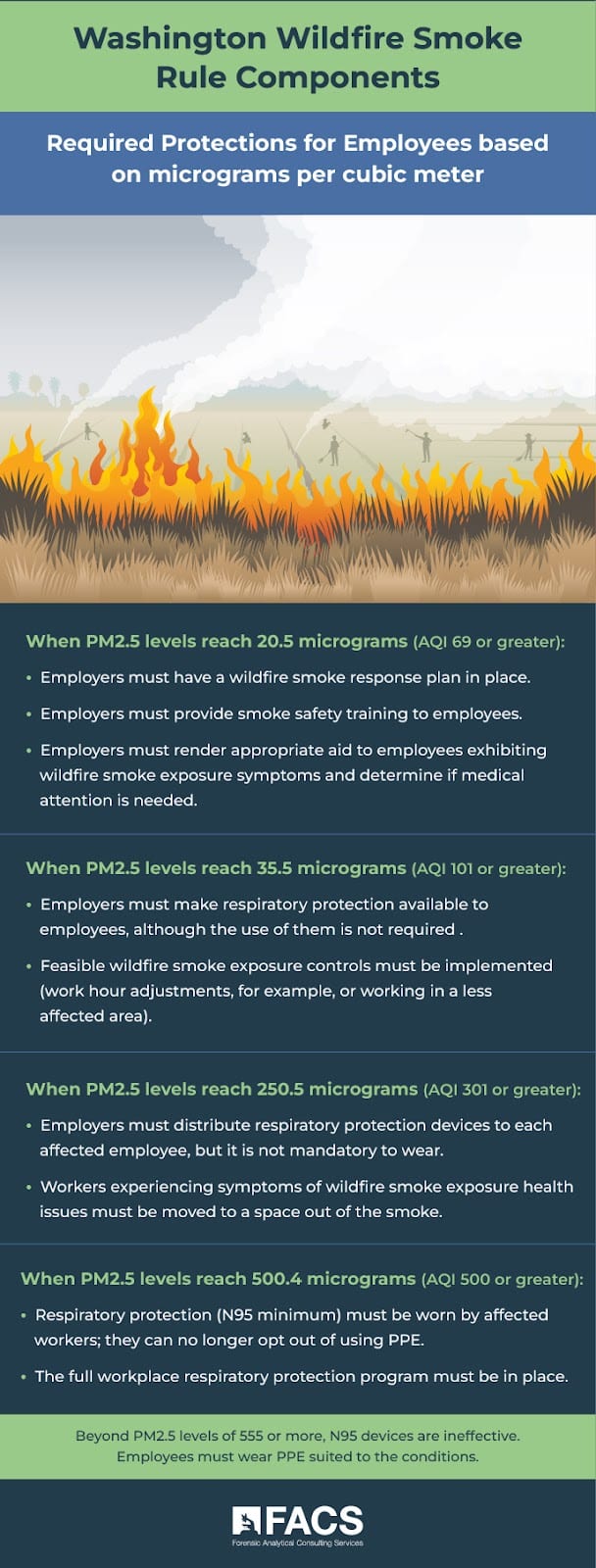Wildfire smoke inhalation can threaten the health of outdoor workers. The past two summer fire seasons in the state of Washington saw conditions warranting the adoption of temporary special worker safety rules to mitigate the issue. Now, the Washington Department of Labor & Industries (L&I) is enacting a permanent wildfire smoke rule.
In this article, we’ll consider the ramification of the threat, the new requirements, and how employers operating in the state of Washington can seamlessly adapt to the new rule to prepare for wildfire smoke events.
Why Is Wildfire Smoke a Health Issue for Outdoor Workers?
Wildfire smoke particulates 2.5 micrometers (PM2.5) or smaller in diameter can penetrate deep into the lungs and even gain access to the bloodstream. Chronic exposure to those particles can lead to problems in the respiratory system and cardiovascular system to create serious long-term health complications. Workers exposed to wildfire smoke are especially at risk, since they often perform many of their duties outdoors under strenuous conditions.
In addition to smoke particulates, wildfire smoke can also contain a myriad of gasses and vapors, leading to further health implications. Workers who are not used to wearing personal protective equipment (PPE) on the job may not be educated on the topic and leave themselves unprotected. You may see a construction worker, for instance, using a bandana to cover their mouth and nose on a dusty worksite, but cotton will not block PM2.5, gasses, or vapors from potentially causing major health concerns.
Components of the Washington Wildfire Smoke Rule
The new Washington Wildfire Smoke Rule will be in effect year-round and will activate whenever workers are exposed to the hazards of wildfire smoke. The rule will provide layers of protection that increase in protective cautions in direct proportion to upticks in PM2.5 levels, and employers may use the Air Quality Index (AQI) to help determine the PM2.5 concentration levels. You can find instructions for how to access and interpret the AQI scores on the federal AirNow website.

Here is the fundamental structure of the rule as it currently stands:
When PM2.5 levels reach 20.5 micrograms per cubic meter (AQI 69) or greater the following protections are required:
- Employers must have a wildfire smoke response plan in place
- Employers must provide effective smoke safety training to employees prior to any exposure
- Employers must render appropriate aid to employees exhibiting wildfire smoke exposure symptoms and determine if medical attention is needed.
When PM2.5 levels reach 35.5 micrograms per cubic meter (AQI 101) or greater the following additional protections are required:
- Employers must make respiratory protection available to employees and encourage employees to use respirators
- Wildfire smoke exposure controls must be implemented, where feasible (e.g., work hour adjustments or working in a different area not as severely impacted by wildfire smoke)
When PM2.5 levels reach 250.5 micrograms per cubic meter (AQI 301) or greater, the requirements of the rule expand accordingly:
- Employers must distribute respiratory protection devices to each affected employee, although the question of whether or not to use PPE is up to the employee; although it is not mandatory
- Workers experiencing symptoms of wildfire smoke health issues due to exposure must be moved to a space out of the smoke
When PM2.5 levels reach 500.4 micrograms per cubic meter (AQI 500) or greater the following are required:
- Respiratory protection (N95 minimum) must be worn by affected workers; they can no longer opt out of using PPE
- The full workplace respiratory protection program must be in place
Beyond PM2.5 levels of 555 or more, N95 devices are ineffective and more protective respiratory protection and PPE is required.
How Can Employers Adapt to the New Wildfire Smoke Rules?
Preparation is the key to smoothly transitioning from the temporary rule to the permanent rule. Employers should review their current wildfire smoke preparedness, response, and recovery plan to make sure it fits the new rule. Employers should also review their employee smoke safety training program and make sure they have the necessary PPE equipment on hand should they be needed.
Employers should also consider alternative ways to proceed with jobs when wildfire smoke becomes an issue. Employers may be able to relocate workers to less affected areas, for instance, or adjust work hours to avoid the most severe periods of PM2.5 levels. These, and additional strategies, can help keep workers on task and adequately protected. Check the Oregon wildfire smoke and California wildfire smoke rule for additional information.
Should you need help making sure you understand the new wildfire smoke rule, reviewing your wildfire smoke preparedness or recovery and response plan, training employees, or have other concerns about the dangers your employees face from wildfire smoke, call FACS at 888-711-9998 or use our contact form to speak with a FACS team member.